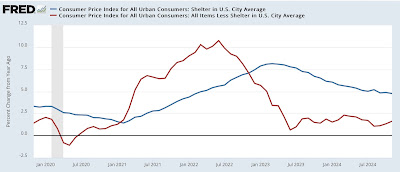- by New Deal democrat
Let me pick up where I left off yesterday discussing trends in consumer prices.
One thing I have done every month for the last couple of years is to review all the categories for any “hot” numbers showing price increases of 4.0% a year or more. And a propos of yesterday, as of this morning we are now down to 2: shelter and transportation services. There are a couple of areas where inflation has picked up in the last few months; namely new and used car prices and also medical care, but so far they remain behaved on a YoY basis.
Probably most of the analysis you will read today will be about the firming of both the headline and core CPI readings, so for the record both increased 0.3% for the month. On a YoY basis, headline prices are up 2.7%, an increase of 0.3% from their 2.4% low two months ago. Core prices excluding food and energy are up 3.3% YoY:
Now let’s look at CPI for shelter vs. ex-shelter:
Shelter prices increased 0.3% for the month. *Everything* else all together *declined* -0.2%. On a YoY basis, shelter increased a little under 4.8%, its lowest such reading in almost 3 years. All other prices increased 1.6% YoY, the 19th month in a row they have risen less than 2.5%.
In the broadest terms, high inflation remains almost all about shelter.
Within shelter, rents increased 0.3%, while “owners equivalent rent,” the fictitious measure of house prices, increased 0.2%. On a YoY basis, rent increased 4.4% while OER increased 4.9%. YoY OER is at a 2.5 year low, while actual rent YoY is close to a 3 year low:
The decline in apartment rents as shown in the Apartment List National Rent Report, as well as the moderation in house price increeases, have both finally shown up in the official CPI. Additionally, the Philadelphia Fed’s experimental new and all rent indexes, which are designed to lead the CPI for rents, for the last two quarters have been forecasting a decline below 4% YoY, and at the current pace of deceleration, that forecast could come to fruition within the next 2 to 3 months.
Now let’s discuss the other remaining problem child, transportation services.
As I wrote yesterday, transportation services (mainly insurance and repair costs) lag vehicle prices. In November, vehicle prices increased a strong 0.9%, while transportation services increased less than 0.1%. On a YoY basis, vehicle prices remain *down* -2.2%, while the increase in transportation services costs slowed to 7.1%, which is bad, but still the lowest in nearly 3 years:
Within transportation services, motor vehicle repairs increased 0.2% for the month, and are 5.7% higher YoY:
This comparison has risen in the last several months, but is still within the range of noise. The real problem child is motor vehicle insurance (for which unfortunately FRED does not provide a graph), higher by only 0.1% for the month, but higher 12.7% YoY!






